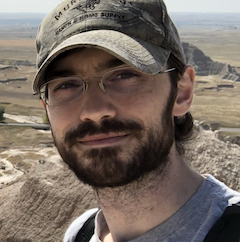Where are we now: Cameron Mercer
Catch up with Center alumni through this periodic feature!
Dr. Cameron Mercer received his doctoral degree in 2017 from the School of Earth and Space Exploration at Arizona State University (ASU), where his dissertation research focused on the “High Spatial Resolution 40Ar/39Ar Geochronology of Lunar Impact Melt Rocks.” For this work he used an ultraviolet laser to precisely target and date impact products in samples returned by the Apollo 16 and 17 missions, and showed how the technique can provide new insights into the chronology of lunar impacts recorded by mono- and polygenetic impact melt rocks.
 Cameron’s research in the Center for Meteorite Studies centered on the quantification of mass-independent anomalies in the neutron rich isotope 54Cr, preserved within calcium-aluminum-rich inclusions (CAIs) found in carbonaceous chondrite meteorites. CAIs were the first formed solids of our Solar System, and these isotopic anomalies provide a unique window into the early evolution of the solar protoplanetary disk.
Cameron’s research in the Center for Meteorite Studies centered on the quantification of mass-independent anomalies in the neutron rich isotope 54Cr, preserved within calcium-aluminum-rich inclusions (CAIs) found in carbonaceous chondrite meteorites. CAIs were the first formed solids of our Solar System, and these isotopic anomalies provide a unique window into the early evolution of the solar protoplanetary disk.
After postdoctoral research at ASU to continue his work on lunar impact geochronology, Mercer started a postdoctoral project in the Mid-Atlantic Noble Gas Research Laboratory (MNGRL) at NASA’s Goddard Space Flight Center in 2019. His efforts working in the MNGRL included upgrading lab instrumentation for noble gas analyses of lunar and meteoritic materials, contributing to research of terrestrial impact craters, and developing new cyber infrastructure to support sample science.
In 2021, Cameron became a Mendenhall research fellow with the U.S. Geological Survey (USGS), working in the Denver Argon Geochronology Laboratory. His current work primarily focuses on conventional and high spatial resolution 40Ar/39Ar geochronology of rocks and alteration minerals associated with a variety of mineral deposits across the US to contribute to USGS Mineral Resource Program research objectives. He also continues to develop new cyber infrastructure for geochronology and sample science, and contributes to ongoing research in framework geology and mapping, thermochronology, and analysis of extraterrestrial materials.